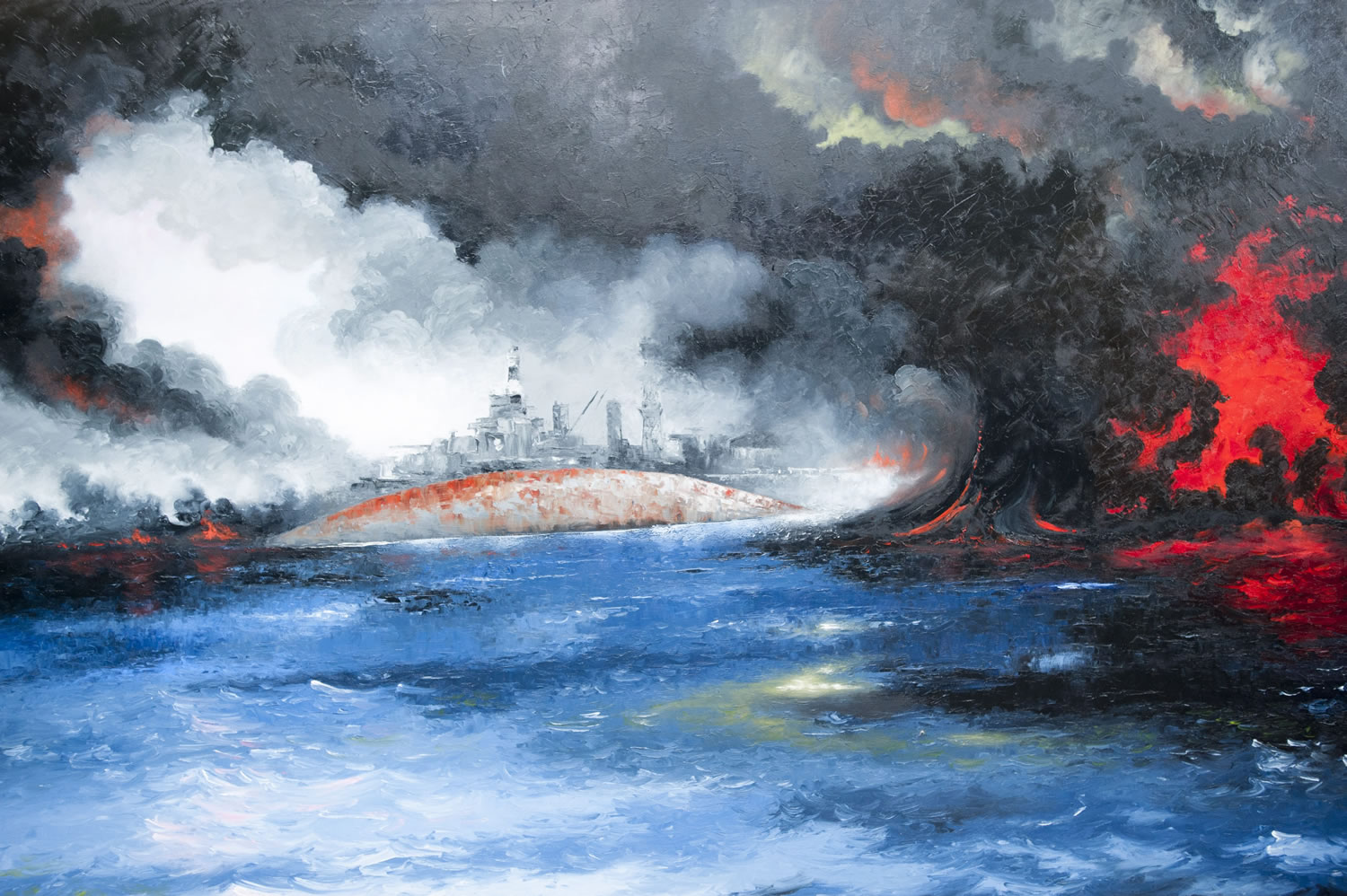When Gordon Sage finally set his memories of Pearl Harbor down on canvas, the artist put his own ship’s position in the background. The USS Maryland was behind a mortally wounded battleship, and well away from the flames licking along the right foreground of his painting.
But Sage didn’t need any special vantage point to see flames on Dec. 7, 1941. They were all over Pearl Harbor.
Seventy-four years ago today, Sage’s ship was tied up alongside the USS Oklahoma on “Battleship Row,” one of the primary targets of Japanese attackers.
And Sage was shining his shoes. The 20-year-old Marine was an admiral’s orderly. His boss was Rear Adm. Walter Stratton Anderson, commander of battleships in the Pacific Fleet.
“I was a go-fer,'” the retired Evergreen High School art teacher explained a few days ago. “He’d say, ‘Get me so and so!’ And I’d have to run and get him.”
After the Japanese warplanes struck at about 7:55 a.m., Sage started hearing explosions. He wasn’t alarmed, however.
“We thought the Army was practicing with its big shore guns,” Sage said.
Then … “A friend came to the door and said, ‘This is it!’ ”
Sage’s puzzled reply: “What’s it?”
“Pearl Harbor is being bombed!”
“I didn’t know whether to believe him or not,” Sage said. “I went to the door, and the Oklahoma was tilting over. Sailors on the Maryland were throwing ropes as best they could” to men in the water.
“I was dumb with disbelief,” Sage said. “They told us they couldn’t sink a battleship.”
When a sergeant yelled at him to go work on a gun crew, the orderly blurted: “I don’t have a helmet.”
No sympathy from the sergeant: “The hell with a helmet: Get out there!”
The young Marine got in a line that was passing ammunition to an anti-aircraft gun, and he eventually joined a firefighting crew.
“The bay was on fire. The flames were right up against the ship,” Sage said.
Then the admiral showed up, and, “I had to put a pressed uniform on,” Sage said.
“The first thing he said was, ‘Put up the American flag!’ ”
The Maryland was hit by two bombs, which killed four crewmen. The battleship was able to steam to Puget Sound Naval Shipyard in Bremerton, where repair crews got the Maryland ready to return to duty.
Two years after Pearl Harbor, the USS Maryland participated in the Battle of Tarawa — one of the island landings that was part of the war in the Pacific. Sage’s battle station during that operation was a 20mm gun.
Sage didn’t consider it combat duty; the only time he felt afraid, Sage said, was when a Japanese shore battery targeted his ship. Their first shot was long. The second shot was short.
“In my estimation, the next one was going to hit us,” Sage said. “It didn’t. It was short, too.”
Sage left shipboard duty behind when he was reassigned to the 4th Marine Division. He took part in the Battle of Iwo Jima, another milestone of the Pacific campaign, as a member of a Marine artillery unit.
After the war, Sage briefly tried art school. But Gordon and wife Patricia had a little girl, Donna, and he figured the military was a better way to support his young family. So he enlisted in the Army. When the Air Force was established as a separate service branch, Sage was given a chance to stay in the Army or move to the new branch.
“I chose the Air Force,” he said.
When he retired from the military in 1961, Sage enrolled at Arizona State University, and graduated with an art degree. The family moved to Vancouver because Sage had family in the area, and he taught art for 20 years at Evergreen High School and what then was Covington Junior High.
Sage’s retirement gave him even more time to paint and create other art, including bronze sculptures; many of them are based on Indian legends he heard while growing up in South Dakota.
Sage’s huge battlescape of Pearl Harbor — it measures 7 feet by 5 feet — was painted in the early 1990s. That was some 50 years after the Japanese attack. And, Donna Sage said, her father was still bothered by those flames.




